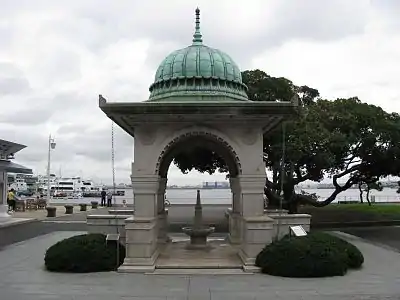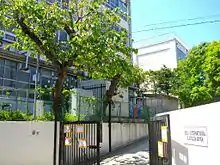Indians in Japan
Indians in Japan consist of migrants from India to Japan and their descendants. As of June 2023, there were 46,262 Indian nationals living in Japan. Indians in Japan are primarily employed in the information technology industry and other office jobs where English language is used.[1][4]
| Total population | |
|---|---|
| 46,262 (in June, 2023)[1][2] | |
| Regions with significant populations | |
| Tokyo, Kobe, Yokohama | |
| Languages | |
| Religion | |
Migration history

According to the Nihon Shoki, in 1654 two men and two women of the Tushara Kingdom, along with one woman from Shravasti, were driven by a storm to take refuge at the former Hyūga Province in southern Kyushu. They remained for several years before setting off for home.[5]
The history of modern Indian settlement in Japan goes back more than a century. As early as 1872, a few Indian businessmen and their families, primarily Parsis and Sindhis, had settled in Yokohama as well as Okinawa.[6] In 1891, Tata, then a small trading firm, established a branch in Kobe.[7] By 1901, Japanese government statistics recorded 30 people from British India living in Japan.[8] Local statistics of the Hyōgo Prefecture government showed 59 Indians living in the prefecture in 1905, among whom all but one were men.[9] After the destruction wreaked on Yokohama in the 1923 Great Kantō earthquake, the Indian traders there also migrated to Kobe; from then on, Kobe became the center of Japan's Indian community's growth.[10]
By 1939, on the eve of World War II, the number of Indians in Hyōgo Prefecture had reached 632. However, due to British sanctions against Japan and the 1941 halt of shipping between Japan and their homeland, many closed their shops and left; by 1942, there were only 114 remaining. Three years after the Partition of India, their numbers had recovered somewhat to 255.[11] Prior to 1990, the Indian community in Japan remained centred on the Kobe area. However, after 1990, the numbers in Tokyo began to show a sharp increase.[12] Migrants who arrived in the 1990s included industrial trainees sent by Japanese car manufacturers which had set up factories in India.[13] IT professionals and their families also came to Tokyo, settling primarily in Setagaya and Minato wards.[14]
Business and employment

As of 2000, there were also around 800 Indians working in the IT industry in Japan, up from 120 in 1993.[15] Kenichi Yoshida, a director of the Softbridge Solutions Japan Co., stated in late 2009 that the Indian engineers are becoming the backbone of Japan's IT industry and that "it is important for Japanese industry to work together with the India."[16][17] Another 870 Indians were employed as cooks.[15] Others are engaged in trading, importing the Indian handicrafts, garments, precious stones, and marine products, and exporting Japanese electronic goods, textiles, automotive parts, and jewellery.[6]
Religion
Indians in Japan speak a number of different languages and follow various religions; there is little correlation between religion or language and profession, except in the case of the Jains, many of whom work in the jewellery industry.[18] The Jains are generally concentrated around Okachi-machi in Taitō, Tokyo.[19] On the whole, Tokyo has fewer religious facilities for Indians than Kobe.[20]
There are Sikh gurudwaras in both Kobe and Tokyo; the latter is of more recent provenance, having been founded in 1999 in the basement of an office building.[21] Some Sikhs employed as unskilled labourers in small and medium enterprises had to cut their hair short and remove their turbans in violation of the principle of kesh, because their employers are unfamiliar with their customs and do not give them any latitude in their style of dress. They consider this as just a temporary adaptation to Japanese society. However, this practise is not common among Sikhs in skilled professions such as IT.[22]
Education
Indians who send their children to school in Japan generally select English-medium schools. The first Indian-specific school, India International School in Japan, was established in 2004 in Tokyo's Koto ward at the initiative of some of the old trading families based in Tokyo and Yokohama.[23] The Global Indian International School, a Singapore-based school, has operated a branch in Tokyo since 2006, and plans to open another in Yokohama in 2008.[20] They follow the Indian Central Board of Secondary Education curriculum. The schools are popular not just among Indian expatriates, but among some Japanese as well, due to a reputation for rigour in mathematics education.[24] Other migrants leave their children behind in their native states, either with grandparents or at the boarding schools, in order to avoid interrupting their education.[23]
Jeevarani "Rani Sanku" Angelina,[25] established the Little Angels International School (now Musashi International School Tokyo), which caters to Japanese students.[26]
Community organizations
One of the earliest Indian community organisations, the Oriental Club, was established in 1904 in Kobe; it changed its name to The India Club in 1913, and continued operating up to the present day. More were founded in the 1930s, including the Indian-dominated Silk Merchants' Association, the Indian Social Society, and the Indian Chamber of Commerce.[9] In 2000, Indian expatriates living in Edogawa, Tokyo, an area with a high concentration of Indian IT engineers founded the Indian Community of Edogawa.[19] Others include the Indian Community Activities Tokyo, whose Diwali celebration draws 2,500 participants, as well as the Indian Merchants Association of Yokohama.[15]
Notable people
- Anastasia Malhotra, professional tennis player (Indian-British/Greek-British father)
- Annu Mari, actress
- Arata Izumi, football player (Indian father)
- Bob Singh Dhillon, businessman
- Bodhisena, Buddhist scholar and monk
- Gonsalo Garcia, Roman Catholic saint
- Pico Iyer, author
- Priyanka Yoshikawa, fashion model
- Sarbjit Singh Chadha, enka singer
- Jaideep Singh, kickboxer
- Yogendra Puranik, a politician
- Koel Purie, actress
See also
Notes
- "【在留外国人統計(旧登録外国人統計)統計表】 | 出入国在留管理庁".
- 令和5年6月末現在における在留外国人数について
- Azuma 2008, p. 258; she lists the religions and languages in alphabetical order therein
- 令和5年6月末現在における在留外国人数について
- Waterhouse 1991, p. 75
- Singhvi 2000, p. 283
- Minamino & Sawa 2005, p. 5
- Minamino & Sawa 2005, p. 4
- Minamino & Sawa 2005, p. 6
- Sawa & Minamino 2007, p. 15
- Minamino & Sawa 2005, p. 7
- Azuma 2008, p. 256
- Azuma 2008, p. 258
- Sawa & Minamino 2007, p. 66
- Singhvi 2000, p. 284
- "FOCUS: Indian engineers becoming backbone of Japan's IT". Kyodo News. Minato, Tokyo. 9 November 2009. Retrieved 6 November 2009.
- "Backbone of Japan's IT industry? Indian engineers!". Rediff.com. Mumbai. 6 November 2009. Retrieved 6 November 2009.
- Azuma 2008, p. 259
- Azuma 2008, p. 262
- Sawa & Minamino 2007, p. 19
- Azuma 2008, p. 264
- Azuma 2008, pp. 263–264
- Sawa & Minamino 2007, p. 21
- Hani, Yoko (11 April 2007), "Indian schools make a mark", Japan Times, retrieved 25 September 2009
- "History Archived 9 March 2015 at the Wayback Machine." Little Angels International School. Retrieved on 9 March 2015.
- Fackler, Martin (2 January 2008). "Losing an Edge, Japanese Envy India's Schools" (PDF). The New York Times. Archived from the original (PDF) on 9 March 2015. Retrieved 9 March 2015.
Unlike other Indian schools, Ms. Angelina said, Little Angels was intended primarily for Japanese children, to meet the need she had found when she sent her sons to Japanese kindergarten.
Sources
- Waterhouse, David (1991), "Where did Toragaku come from?", in Marett, Allan (ed.), Musica Asiatica, vol. 6, Cambridge: Cambridge University Press, pp. 73–94, doi:10.1017/CBO9780511896071.006, ISBN 978-0-521-39050-7
- Singhvi, L. M. (2000), "Asia-Pacific Region" (PDF), Report of the High Level Committee on the Indian Diaspora, New Delhi: Ministry of External Affairs, pp. 273–288, archived from the original (PDF) on 6 February 2012
- Minamino, Takeshi; Sawa, Munenori (2005), 在日インド人社会の変遷--定住地神戸を事例として [Changes in Indian society in Japan—focused on the case of Kobe residents] (PDF), 兵庫地理 (in Japanese), vol. 50, pp. 4–15, archived from the original (PDF) on 8 December 2015, retrieved 25 September 2009
- Sawa, Munenori; Minamino, Takeshi (2007), "Emerging of An Indian Community in Tokyo: A Case Study of Nishikasai" (PDF), The Indian Geographical Journal, 82 (1): 7–26, archived from the original (PDF) on 22 December 2021, retrieved 28 September 2009
- Azuma, Masako (2008), "Indians in Tokyo and its vicinity", in Kesavapany, K.; Mani, A.; Ramasamy, Palanisamy (eds.), Rising India and Indian communities in East Asia, Institute of Southeast Asian Studies, pp. 255–269, ISBN 978-981-230-799-6
Further reading
- Eston, Elizabeth (2019). Rash Behari Bose: The Father of the Indian National Army, Vols 1-6. Tenraidou.
- Green, Nile (2013). "Shared infrastructures, informational asymmetries: Persians and Indians in Japan, c.1890–1930". Journal of Global History. 8 (3): 414–435. doi:10.1017/S1740022813000351. ISSN 1740-0228. S2CID 162765204.
- Sawa, Munenori (April 2008), "Indian society in Japan" 日本のインド人社会, in Yamashita, Kiyomi (ed.), エスニック・ワールド:世界と日本のエスニック社会 [Ethnic World: Global and Japanese ethnic societies], Akashi Shoten, ISBN 978-4-7503-2758-7, OCLC 226814973
- Sawa, Munenori (October 2008), グローバリゼーション下のディアスポラ ―在日インド人のネットワークとコミュニティ [Diaspora under globalisation: Networks and community of Indians in Japan] (PDF), 院人間発達環境学研究科報告書, vol. 13680081, Kobe University, archived from the original (PDF) on 3 June 2022, retrieved 28 September 2009





